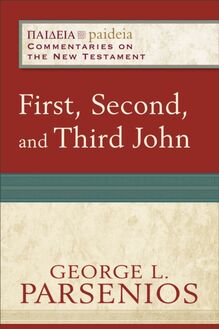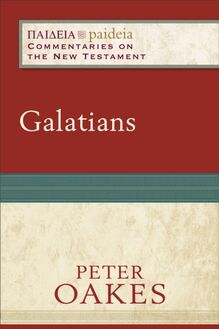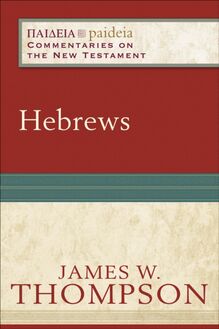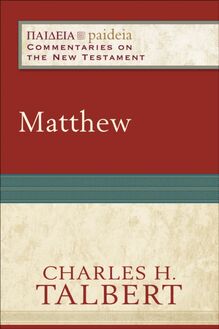First, Second, and Third John (Paideia: Commentaries on the New Testament) , livre ebook
174
pages
English
Ebooks
2014
Vous pourrez modifier la taille du texte de cet ouvrage
Obtenez un accès à la bibliothèque pour le consulter en ligne En savoir plus
Découvre YouScribe en t'inscrivant gratuitement
Découvre YouScribe en t'inscrivant gratuitement
174
pages
English
Ebooks
2014
Vous pourrez modifier la taille du texte de cet ouvrage
Obtenez un accès à la bibliothèque pour le consulter en ligne En savoir plus
Publié par
Date de parution
11 novembre 2014
Nombre de lectures
0
EAN13
9781441221018
Langue
English
Poids de l'ouvrage
1 Mo
Publié par
Date de parution
11 novembre 2014
Nombre de lectures
0
EAN13
9781441221018
Langue
English
Poids de l'ouvrage
1 Mo
G ENERAL E DITORS
Mikeal C. Parsons, Charles H. Talbert, and Bruce W. Longenecker
A DVISORY B OARD
† Paul J. Achtemeier
Loveday Alexander
C. Clifton Black
Susan R. Garrett
Francis J. Moloney
© 2014 by George L. Parsenios
Published by Baker Academic
a division of Baker Publishing Group
PO Box 6287, Grand Rapids, MI 49516-6287
www.bakeracademic.com
Ebook edition created 2014
All rights reserved. No part of this publication may be reproduced, stored in a retrieval system, or transmitted in any form or by any means—for example, electronic, photocopy, recording—without the prior written permission of the publisher. The only exception is brief quotations in printed reviews.
Library of Congress Cataloging-in-Publication Data is on file at the Library of Congress, Washington, DC.
ISBN 978-1-4412-2101-8
Unless otherwise indicated, all quotations from the Letters of John are the author’s own translation.
Unless otherwise indicated, all other Scripture quotations are from the New Revised Standard Version of the Bible, copyright © 1989, by the Division of Christian Education of the National Council of the Churches of Christ in the United States of America. Used by permission. All rights reserved.
For Fr. Zosimas of Xenophontos
Contents
Cover
Series Page
Title Page
Copyright Page
Dedication
List of Figures and Tables
Foreword
Preface
Abbreviations
Introduction to the Letters of John
1 John 1:1–4 Introductory Prologue
1 John 1:5–2:11 The Light and the Darkness
1 John 2:12–3:10 Who Are the Children of God?
1 John 3:11–4:21 Love for God, Love for One Another
1 John 5:1–21 Testimony and Witnesses
2 John A Letter to the Elect Lady
3 John A Letter to the Beloved Gaius
Bibliography
Index of Subjects
Index of Modern Authors
Index of Scripture and Ancient Sources
Back Cover
Figures and Tables
Figures
1. Christ enthroned in majesty. Weingarten Gospels, Tours, ca. 830.
2. John the Evangelist, enthroned in majesty, facing the viewer in the manner of Christ in the same manuscript. Weingarten Gospels, Tours, ca. 830.
3. John the Evangelist, seated in glory, facing the viewer in the manner of Christ in the same manuscript. Miniature added at Trier, ca. 1000, to a Gospel book from St. Maximian, Mainz, ca. 900–950.
4. Luke the Evangelist, writing at his desk. Miniature added at Trier, ca. 1000, to a Gospel book from St. Maximian, Mainz, ca. 900–950.
5. Depiction of Jesus as the Light of the World. Saint Lawrence Parish Church, New Jersey.
6. Nicodemus and Jesus by Alexandre Bida, 1874.
7. The Seven-Headed Beast and the Beast with Lamb’s Horns by Albrecht Dürer.
8. Cain Killing Abel by Gaetano Gandolfi.
Tables
1. Characteristic Language of the Gospel and Letters of John
2. Common Phrases and Syntax in John and 1 John
3. Further Common Phrases Shared by John and 1 John
Foreword
Paideia: Commentaries on the New Testament is a series that sets out to comment on the final form of the New Testament text in a way that pays due attention both to the cultural, literary, and theological settings in which the text took form and to the interests of the contemporary readers to whom the com mentaries are addressed. This series is aimed squarely at students—including MA students in religious and theological studies programs, seminarians, and upper-division undergraduates—who have theological interests in the biblical text. Thus, the didactic aim of the series is to enable students to understand each book of the New Testament as a literary whole rooted in a particular ancient setting and related to its context within the New Testament.
The name “Paideia” (Greek for “education”) reflects (1) the instructional aim of the series—giving contemporary students a basic grounding in academic New Testament studies by guiding their engagement with New Testament texts; (2) the fact that the New Testament texts as literary unities are shaped by the educational categories and ideas (rhetorical, narratological, etc.) of their ancient writers and readers; and (3) the pedagogical aims of the texts themselves—their central aim being not simply to impart information but to form the theological convictions and moral habits of their readers.
Each commentary deals with the text in terms of larger rhetorical units; these are not verse-by-verse commentaries. This series thus stands within the stream of recent commentaries that attend to the final form of the text. Such reader-centered literary approaches are inherently more accessible to liberal arts students without extensive linguistic and historical-critical preparation than older exegetical approaches, but within the reader-centered world the sanest practitioners have paid careful attention to the extratext of the original readers, including not only these readers’ knowledge of the geography, history, and other contextual elements reflected in the text but also their ability to respond correctly to the literary and rhetorical conventions used in the text. Paideia commentaries pay deliberate attention to this extratextual repertoire in order to highlight the ways in which the text is designed to persuade and move its readers. Each rhetorical unit is explored from three angles: (1) introductory matters; (2) tracing the train of thought or narrative or rhetorical flow of the argument; and (3) theological issues raised by the text that are of interest to the contemporary Christian. Thus, the primary focus remains on the text and not its historical context or its interpretation in the secondary literature.
Our authors represent a variety of confessional points of view: Protestant, Catholic, and Orthodox. What they share, beyond being New Testament scholars of national and international repute, is a commitment to reading the biblical text as theological documents within their ancient contexts. Working within the broad parameters described here, each author brings his or her own considerable exegetical talents and deep theological commitments to the task of laying bare the interpretation of Scripture for the faith and practice of God’s people everywhere.
Mikeal C. Parsons Charles H. Talbert Bruce W. Longenecker
Preface
My previous research and writing have focused on the Fourth Gospel, but one cannot for very long study that book without turning one’s attention closely to 1–3 John. Writing this commentary has provided an invaluable opportunity to reflect on the connections that link these texts, and I would like to thank the editors of the Paideia series for asking me to produce this volume. C. Clifton Black deserves special thanks for the personal support and encouragement he offered from the very start. Charles Talbert, Mikeal Parsons, and Bruce Longenecker have offered insightful editorial help, and they showed tremendous patience when the volume took much longer to complete than originally planned. Their suggestions improved the book in every instance. From Baker Academic, James Earnest guided the work from beginning to end with expert care, while Rachel Klompmaker prepared the beautiful artwork, and the various Baker editors were always insightful, saving me from more than a few embarrassing errors. Portions of the introductory chapter reproduce elements from my essay “A Sententious Silence: First Thoughts on the Fourth Gospel and the Ardens Style,” in Portraits of Jesus: Essays in Honor of Harold W. Attridge , edited by Susan Myers; and portions of the commentary on 2 John reproduce elements from my essay “‘No Longer in the World’ (John 17:11): The Transformation of the Tragic in the Fourth Gospel.” Harvard Theological Review 98 (2005): 1–21. Both texts are used here by permission. Finally, this book is dedicated as a small token of friendship to Fr. Zosimas of the Holy Monastery of Xenophontos on Mt. Athos.
Abbreviations
General
AT author’s translation BCE before the Common Era (= BC) ca. circa , approximately CE the Common Era (= AD) cf. confer , compare ed. edition, edited by, editor d. died fl. flourished in (year) i.e. id est , that is NT New Testament OT Old Testament rev. revised trans. translator, translation, translated by x times v./vv. verse/verses
Bible Texts, Editions, and Versions
JB Jerusalem Bible KJV King James (Authorized) Version LXX Septuagint, the Greek Bible NABRE New American Bible, Revised Edition NASB New American Standard Bible NEB New English Bible NIV New International Version (2011) NRSV New Revised Standard Version RSV Revised Standard Version
Ancient Manuscripts, Papyri, and Inscriptions
P.Flor. Papiri greco-egizii, Papiri Fiorentini . Supplementi Filologico-Storici ai Monumenti Antichi. Milan, 1906–15. P.Oslo Papyri Osloenses . 3 vols. Oslo, 1925–36. P.Oxy. The Oxyrhynchus Papyri . 75 vols. London, 1898–2010. P.Ryl. Catalogue of the Greek and Latin Papyri in the John Rylands Library, Manchester . Manchester, UK, 1911–52. PSI Pubblicazione della Società Italiana per la ricerca dei papiri Greci e Latini in Egitto. Papiri Greci e Latini. Florence, 1912–.
Ancient Corpora
O LD T ESTAMENT
Gen. Genesis
Exod. Exodus
Lev. Leviticus
Num. Numbers
Deut. Deuteronomy
Josh. Joshua
Judg. Judges
Ruth Ruth
1–2 Sam. 1–2 Samuel
1–2 Kings 1–2 Kings
1–2 Chron. 1–2 Chronicles
Ezra Ezra
Neh. Nehemiah
Esther Esther
Job Job
Ps(s). Psalm(s)
Prov. Proverbs
Eccles. Ecclesiastes
Song Song of Songs
Isa. Isaiah
Jer. Jeremiah
Lam. Lamentations
Ezek. Ezekiel
Dan. Daniel
Hosea Hosea
Joel Joel
Amos Amos
Obad. Obadiah
Jon. Jonah
Mic. Micah
Nah. Nahum
Hab. Habakkuk
Zeph. Zephaniah
Hag. Haggai
Zech. Zechariah
Mal. Malachi
D EUTEROCANONICAL B OOKS
Bar. Baruch
1–2 Esd. 1–2 Esdras
Tob. Tobit
Wis. Wisdom of Solomon
N EW T ESTAMENT
Matt. Matthew
Mark Mark
Luke Luke
John John
Acts Acts
Rom. Romans
1–2 Cor. 1–2 Corinthians
Gal. Galatians
Eph. Ephesians
Phil. Philippians
Col. Colossians
1–2 Thess. 1–2 Thessalonians
1–2 Tim. 1–2 Timothy
Titus Titus
Philem. Phile









